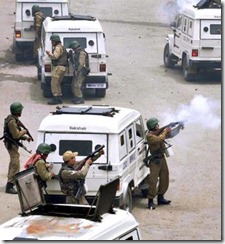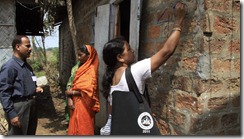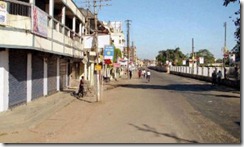By Sonia Wahengbam
 The blockade by Naga groups of National Highway 39 to Manipur has sent the prices of essential commodities skyrocketing and started a thriving black market in the state, where you can get petrol for Rs 150 a litre and a gas cylinder for Rs 2,000. Sonia Wahengbam writes on life in times of an economic blockade
The blockade by Naga groups of National Highway 39 to Manipur has sent the prices of essential commodities skyrocketing and started a thriving black market in the state, where you can get petrol for Rs 150 a litre and a gas cylinder for Rs 2,000. Sonia Wahengbam writes on life in times of an economic blockade
These days in Imphal, television dealers have come up with a new offer. Buy a TV set and get a Tata Sky connection or 10 litres of petrol free. With petrol selling for Rs 150 per litre in Manipur and still hard to get, free petrol certainly seems a more tempting offer than satellite TV connection.
It’s been 50 days since National Highway 39 —Manipur’s lifeline where on an average day 300 trucks ply, carrying essential commodities to the state — has remained blocked. When the blockade was first enforced on April 11, many in the state simply shrugged. Bandhs and blockades are routine in Manipur and follow a predictable pattern. They go on for a few days, or a couple of weeks — the exception was the 52-day blockade in 2005 — before an agreement is hammered out and then it’s back to normal. But this time the days have stretched to over a month. It’s hard to shrug now.
What’s surprising is that there have hardly been any protests over the issue. Have Manipuris become so docile that we have forgotten how to protest, or have we become so much of an ‘I-me-myself’ society that we really don’t care about our neighbours as long as we are protected? Or are some of us too rich to bother about skyrocketing prices and scarcity of essential items? Perhaps, as long as our mini-godowns at home remain stocked, we think we’re going to be fine.
But it’s time to worry. Everywhere you go in Manipur, the talk veers towards the economic blockade. And everybody is busy looking for black marketers. Instead of thinking of a solution to end the impasse, a common query is, ‘Where can I find good quality petrol and diesel?’
And even though the price of a bag of cement has nearly doubled from Rs 350 to Rs 600, construction in the state is on in full swing.
The prices are showing no signs of dipping. A cylinder of gas is now costlier by about Rs 1,600 and lighter by about 10 kg. The fare for public transport has increased from Rs 5 to Rs 10. Any vegetable you buy, even if it’s grown in Manipur, comes with the economic blockade price tag.
For the past few months, the government employees in the Manipur have been protesting over the issue of Sixth Pay Commission arrears in the state. But the prices we are paying for essential items are what we should be paying after the Tenth Pay Commission!
Says Th Manglem, a state government employee, “The blockade has hit me and my family badly. We haven’t got our salary for the past two months because of the Sixth Pay Commission impasse and now this blockade. It’s a double blow.”
EVERY year, the NH-39 to Manipur is blocked at least a couple of times, mostly by Naga groups who live primarily in the hill areas in the state, areas they want integrated into what they call Nagalim or Greater Nagaland. The Thuingaleng Muivah-led Nationalist Socialist Council has been spearheading the demand for Nagalim, comprising Nagaland and the Naga-dominated areas of neighbouring Manipur, Assam and Arunachal Pradesh.
According to a study conducted by the state government, Manipur suffered an accumulated loss of Rs 1,320 crore due to bandhs and blockades between 2004-05 and 2006-07. The state witnessed 110 bandhs and 234 economic blockades during the period — 20 days of bandhs and 60 days of economic blockades in 2004-05, which rose to 48 days and 97 days in 2005-06 and 42 days and 77 days in 2006-07. The study also says the per capita income of the state decreased by 6.10 per cent in 2004-05, 11.79 per cent in 2005-06 and 9.93 per cent in 2006-07.
“In the first few days of any blockade, the economic loss is not much—maybe a crore or so as there are items in stock, but if it carries on, then there is cumulative impact on the economic condition and by the 45th-50th day, the damage is around Rs 15-20 crore. If we talk in terms of growth rate, there is a slowdown of 1.5-2 per cent,” says Prof Amar Yumnam, Department of Economics, Manipur University.
The economic blockade this time has been called by the All Naga Students’ Association of Manipur, opposing the state government’s decision to hold elections to the district councils in the state’s hill districts. It intensified after Manipur refused to let Muivah visit his village in the state’s Ukhrul district on May 4, and the Naga Students’ Federation declared they would not allow any vehicle from Manipur to enter Nagaland.
Every day, we open the newspaper eagerly to see if any goods trucks have started coming in. Every day we are disappointed. But then we think, there’s always tomorrow.
And that fortunate tomorrow came on May 22, when 97 of the 306 trucks stranded after the blockade reached Imphal through an alternative route, National Highway 53, which connects Imphal with Jiribam in Assam. This route is not safe either and the Nagas have called for a blockade of it too. Apart from that, it’s not in great shape.
The remaining trucks reached the following day, getting with them eatables, petrol, diesel and LPG. The trucks were accompanied by State Food and Civil Supplies Minister Y Erabot and a handful of his security personnel. Erabot and his team were assisted by troops of the Assam Rifles, CRPF and BSF. The supplies arrived. The chaos in distribution followed.
After the state government announced it would ration sale of petrol, the queues of vehicles at petrol pumps grew so long that some of them lasted for two days. At all hours, the queues were at least three to four kilometres long.
And there are a lot of people out on the roads at night, outside petrol stations, sleeping inside their cars so as to keep their place in the queue. It must be a bit disconcerting, after getting one’s ration of 10 litres of petrol after such a long wait, to wake up the next day to headlines such as, “After 48 hours in queue, consumers end up buying blue petrol”—the blue referring to adulteration with kerosene oil. There are, of course, ways of beating the queue. Rows of vendors are still selling petrol in mineral water bottles outside pumps for Rs 150-170 per litre.
Says 52-year-old Ibeyaima, a petrol vendor, “Our business comes up only when there is a blockade. When I get news that there is going to be a blockade, I go out and buy as much petrol as I can with whatever little money I have so that I can sell it later at a higher price. The petrol I am selling is what I had stocked before the blockade started. I have made a good profit, but then all this money goes into buying rice and other household items, whose prices have shot up as well. So, it is more of a give and take. If I don’t do this, my family of seven won’t be able to survive in this condition.”
With fuel being scarce, many schools and tuition centres have called pre-summer breaks. Says Sangeeta, a class IX student, “Last year, schools were closed after protests over an encounter death broke out and now this blockade. We are missing out on a lot of classes.”
The worst affected has been healthcare, with many operations being cancelled, life-saving drugs unavailable, and oxygen cylinders out of stock in the hospitals.
The crisis may not be killing us yet, but it’s killing us off in bits. Manipur seems almost like a war zone, minus the sound of bomb blasts and bullets. And yet, when we think things can’t get any worse, it seems they can. After the blockade, there’s now the threat of counter-blockade. The people from the Imphal Valley have declared that since it’s the Nagas who enforced the blockade, sections of the hills of Manipur, where the Nagas live, will not get any supply from the valley.
Of the nine districts in Manipur, the Naga-inhabited districts are Senapati, Ukhrul, Chandel and Tamenglong. Bishnupur, Imphal East, Imphal West and Thoubal are dominated by Meitei and Manipuri Muslims and the Kukis inhabit the district of Churachandpur.
There are also reports that Manipuris living in Assam are planning to block the land route to Nagaland. The fire that began in Manipur now threatens to spread in the region.
The crisis grows bigger, but there’s no solution in sight. So, we move on, everyone looking out for themselves, willing to pay extraordinary prices for ordinary stuff. Earning in rupees and paying in pounds and doing what we do best: making the best of a bad situation.
Sonia Wahengbam, a former Express journalist, teaches in the Department of Mass Communication at Manipur University
 ..you might be heard
..you might be heard 

















